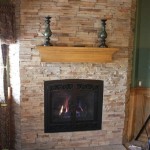Can Granite Be Used For A Fireplace Hearth?
The fireplace hearth serves as a crucial component of any fireplace, providing both aesthetic appeal and, more importantly, a functional barrier against the potential hazards of fire. The hearth extends outward from the fireplace opening, protecting the surrounding flooring and combustible materials from sparks, embers, and radiant heat. Choosing the right material for a fireplace hearth is therefore a decision that requires careful consideration, balancing visual preferences with practical performance criteria. Granite, a natural stone celebrated for its durability and heat resistance, is often considered as a potential option. This article will explore the suitability of granite as a fireplace hearth material, examining its properties, advantages, and potential disadvantages.
The primary function of a fireplace hearth is fire safety. It must be able to withstand high temperatures without cracking, warping, or combusting. A properly constructed hearth provides a non-combustible zone that prevents accidental fires from spreading to the surrounding structure. The size of the hearth is also important, as building codes typically dictate minimum dimensions based on the size and design of the fireplace. Larger fireplaces, for example, usually require a larger hearth to provide adequate protection. Furthermore, the hearth can act as a decorative element, complementing the fireplace design and enhancing the overall ambiance of the room. The material choice will significantly influence the aesthetic character of the fireplace area.
Granite is an igneous rock formed from the slow cooling of magma deep beneath the Earth's surface. This geological process results in a dense, hard, and durable material composed primarily of quartz, feldspar, and mica. Granite is known for its exceptional strength, resistance to abrasion, and natural beauty. It is available in a wide range of colors and patterns, making it a versatile choice for various design applications. Granite is commonly used in kitchen countertops, flooring, and building facades, prized for its long-lasting performance and aesthetic appeal. However, before deciding to use granite for a fireplace hearth, it is vital to assess its specific properties in relation to the demands of that application.
Heat Resistance and Thermal Expansion
One of the key considerations when evaluating granite for a fireplace hearth is its ability to withstand high temperatures. Granite, in general, exhibits excellent heat resistance. It does not readily combust or melt at the temperatures typically reached in a residential fireplace. The mineral composition of granite contributes to its thermal stability, allowing it to withstand significant temperature fluctuations without undergoing significant structural changes. However, it is important to understand that granite, like all materials, is subject to thermal expansion. When heated, granite will expand slightly, and when cooled, it will contract. This expansion and contraction can create stress within the stone, potentially leading to cracks or fissures over time if the hearth is not properly installed and maintained.
The rate of thermal expansion varies depending on the specific type of granite, as different granites have slightly different mineral compositions. Darker granites, for example, tend to absorb more heat and may experience greater thermal expansion than lighter-colored granites. It is therefore advisable to consult with a stone specialist or fireplace installer to determine the most suitable type of granite for the specific fireplace application, taking into account the expected operating temperatures and the overall design of the fireplace. Proper installation techniques, such as using expansion joints to accommodate movement, are crucial to minimize the risk of cracking due to thermal stress.
Furthermore, it is essential to avoid sudden temperature changes on the granite hearth. Rapid heating or cooling can induce thermal shock, which can cause the stone to crack or break. Therefore, it is recommended to gradually increase the heat in the fireplace rather than starting with a large fire. Similarly, avoid splashing cold water on a hot granite hearth, as this can also lead to thermal shock. Proper maintenance, including regular cleaning and inspection for cracks, can help prolong the lifespan of a granite fireplace hearth.
Durability and Maintenance
Granite is renowned for its exceptional durability, making it a long-lasting choice for a fireplace hearth. Its resistance to scratching, abrasion, and staining ensures that it can withstand the wear and tear associated with fireplace use. Unlike some other materials, such as wood or laminate, granite is not susceptible to burning or charring from stray embers. This inherent fire resistance contributes to the safety and longevity of the hearth. However, while granite is a robust material, it is not entirely impervious to damage. Heavy impacts or dropped objects can potentially chip or crack the stone. Therefore, it is important to handle heavy fireplace accessories with care and avoid placing excessive weight on the hearth.
Maintaining a granite fireplace hearth is relatively straightforward. Regular cleaning with a mild soap and water solution is typically sufficient to remove dirt, soot, and ash. Avoid using harsh chemicals or abrasive cleaners, as these can damage the surface of the granite. It is also advisable to seal the granite to protect it from stains and moisture penetration. Sealing helps to create a barrier that prevents liquids from seeping into the pores of the stone, making it easier to clean up spills and prevent permanent discoloration. Depending on the type of sealer used, it may need to be reapplied periodically to maintain its effectiveness.
In addition to regular cleaning and sealing, it is important to inspect the granite hearth periodically for any signs of cracks or damage. Small cracks can often be repaired by a professional stone restoration specialist. However, if the cracks are large or extensive, it may be necessary to replace the affected section of the hearth. Addressing any damage promptly can prevent it from worsening and potentially compromising the structural integrity of the hearth. With proper care and maintenance, a granite fireplace hearth can provide many years of reliable performance and aesthetic appeal.
Aesthetic Considerations and Design Options
Granite offers a wide range of aesthetic possibilities for a fireplace hearth. Its natural beauty, combined with the variety of colors and patterns available, allows for a customized look that complements the overall design of the room. Granite is available in a spectrum of colors, ranging from light grays and whites to dark blacks and browns, with various shades of red, green, and blue in between. The patterns in granite are created by the arrangement of the different minerals within the stone, resulting in unique and visually appealing textures. This natural variation ensures that each granite hearth is one-of-a-kind.
The edge profile of the granite hearth can also be customized to suit the desired aesthetic. Common edge profiles include square, beveled, rounded, and ogee. The choice of edge profile can significantly influence the overall look and feel of the hearth. A square edge provides a clean and modern look, while a rounded edge offers a softer and more traditional appearance. The size and shape of the hearth can also be tailored to fit the specific dimensions of the fireplace and the surrounding space. A larger hearth can create a more dramatic focal point, while a smaller hearth can be more subtle and understated.
Furthermore, granite can be combined with other materials, such as brick, stone, or wood, to create a unique and visually interesting fireplace surround. For example, a granite hearth can be paired with a brick fireplace surround to create a rustic and traditional look. Alternatively, a granite hearth can be combined with a sleek and modern fireplace surround made of stainless steel or glass. The possibilities are virtually endless, allowing for a high degree of customization to achieve the desired aesthetic. The selection of granite should consider the color palette of the room and the style of the fireplace. The goal is to create a harmonious and visually appealing focal point that enhances the overall ambiance of the space.

China Customized Granite Slab For Fireplace Hearth Suppliers Whole Service Xuri Stone

Fireplace Mantel Surround With Granite Hearth Monk S In

Custom Granite Hearths Made To Measure Hearth Delivery

Why Granite Is Great For Your Fireplace Mees Distributors Inc

Why Is Granite A Great Choice For Fireplace

Old Granite Fireplace Need Inspiration And Decoration Ideas

Beyond Worktops Elevating Your Home With Fireplace Hearths Portman Stone

Granite Hearths For Multi Fuel Stoves Castfireplaces

Modern Fireplace Surrounds To Inspire Your Home

Stone Fireplace Ideas For Your Home In 2025 Marble Com
Related Posts








